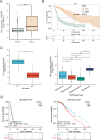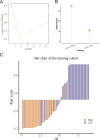Predicting podoplanin expression and prognostic significance in high-grade glioma based on TCGA TCIA radiomics
- PMID: 40554484
- PMCID: PMC12186906
- DOI: 10.1371/journal.pone.0325964
Predicting podoplanin expression and prognostic significance in high-grade glioma based on TCGA TCIA radiomics
Abstract
Background: Podoplanin (PDPN) is a membrane glycoprotein implicated in tumor invasion and immune modulation in high-grade gliomas (HGGs). However, the non-invasive prediction of PDPN expression and its prognostic significance using radiomics remains unexplored.
Materials and methods: This study used preoperative contrast-enhanced MRI T1WI data analyzed by gradient boosting machine to predict podoplanin (PDPN) expression and overall survival (OS) in HGG patients.
Results: We retrospectively analyzed 89 HGG patients' clinical data, MRI images, and RNA-seq profiles from TCIA. For each patient, 107 radiomics features were extracted from HGG subregions. The radiomics prognostic model was built using two selected features, glcm_Idmn and glcn_Idn. Through validation with external the REMBRANDT dataset (n=39), the model demonstrated great predictive performance for the PDPN expression levels and OS in HGG. The area under the curve of the ROC in the radiomics signature combined with clinical risk factors for the 1-year, 2-year, and 3-year OS rates in the TCIA-HGG were 0.799, 0.883, and 0.923, respectively. Gradient boosting machine using preoperative MRI T1WI and extracted radiomics features performed well in predicting the expression of PDPN and OS in HGG.
Conclusions: Radiomics features extracted from MRI images can non-invasively predict PDPN expression and prognosis in HGG, offering a potential imaging biomarker for individualized clinical management.
Copyright: © 2025 Long et al. This is an open access article distributed under the terms of the Creative Commons Attribution License, which permits unrestricted use, distribution, and reproduction in any medium, provided the original author and source are credited.
Conflict of interest statement
The authors have declared that no competing interests exist.
Figures








Similar articles
-
Survival prediction in gliomas based on MRI radiomics combined with clinical factors and molecular biomarkers.PeerJ. 2025 Aug 20;13:e19906. doi: 10.7717/peerj.19906. eCollection 2025. PeerJ. 2025. PMID: 40860684 Free PMC article.
-
Magnetic resonance perfusion for differentiating low-grade from high-grade gliomas at first presentation.Cochrane Database Syst Rev. 2018 Jan 22;1(1):CD011551. doi: 10.1002/14651858.CD011551.pub2. Cochrane Database Syst Rev. 2018. PMID: 29357120 Free PMC article.
-
Magnetic Resonance Imaging Radiomics-Driven Artificial Neural Network Model for Advanced Glioma Grading Assessment.Medicina (Kaunas). 2025 Jun 3;61(6):1034. doi: 10.3390/medicina61061034. Medicina (Kaunas). 2025. PMID: 40572722 Free PMC article.
-
Survival prediction with radiomics for patients with IDH mutated lower-grade glioma.J Neurooncol. 2025 Jul;173(3):505-514. doi: 10.1007/s11060-025-05006-z. Epub 2025 Mar 18. J Neurooncol. 2025. PMID: 40100522 Free PMC article.
-
Advanced MRI, Radiomics and Radiogenomics in Unravelling Incidental Glioma Grading and Genetic Status: Where Are We?Medicina (Kaunas). 2025 Aug 12;61(8):1453. doi: 10.3390/medicina61081453. Medicina (Kaunas). 2025. PMID: 40870498 Free PMC article. Review.
References
MeSH terms
Substances
LinkOut - more resources
Full Text Sources
Medical

